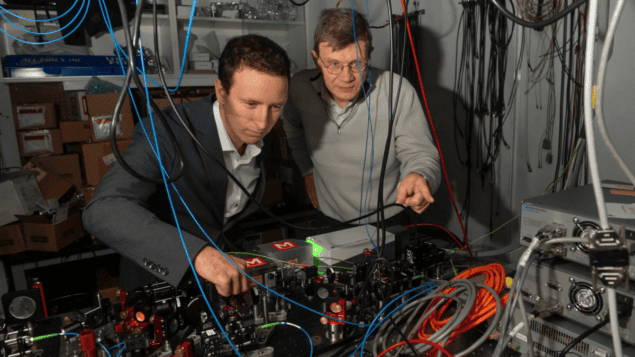
A quantum processor with 48 logical qubits that can execute algorithms while correcting errors in real time has been unveiled in the US. It was created by Mikhail Lukin and colleagues at Harvard University, the Massachusetts Institute of Technology and QuEra . Their success could lead to the development of quantum computers that offer large numbers of logical qubits.
In principle, quantum computers can solve some problems that cannot be computed on conventional processors. However, the quantum processors available today are very susceptible to disruption by environmental noise, which destroys the delicate quantum states that are used to store and process information.
Quantum error correction addresses the noise problem by having a group of qubits (called physical qubits) work together as one qubit, which is called a logical qubit. The idea is that the information held by a logical qubit is spread out over a number of physical qubits, which work together to identify and correct errors as they occur.
Resilient against errors
Researchers hope to use logical qubits to replace individual qubits in quantum computing architectures, making them resilient against errors when running algorithms.
“We are trying to mark a transition in the field, toward starting to test algorithms with error-corrected qubits instead of physical ones, and enabling a path toward larger devices,” explains Dolev Bluvstein, who is the lead author of a paper describing the work. The paper has been accepted for publication in Nature.
This concept is still in its very early stages and recently, experiments reached the milestone of using two logical qubits to operate a single quantum logic gate.
In their study, Lukin’s team explored how a much larger system could be created using neutral atom arrays. These are grids of ultracold rubidium atoms trapped by optical tweezers. These atoms can be put into highly-excited Rydberg states, which enables the atoms to act as qubits that can exchange quantum information.
Dynamic reconfiguration
Neutral atom arrays are especially well suited for logical qubit architectures as they can be dynamically reconfigured during a computation, while preserving their quantum information.
Taking advantage of these properties, Lukin and colleagues created a programmable quantum processor that is based on the control of logical qubits in neutral atom arrays, and used their platform to run a series of programmable logical algorithms. The team’s approach allowed them to vastly improve on the results of recent experiments: encoding up to 48 logical qubits, containing up to 228 two-qubit logic gates.
With its in-built error correction, the processor dramatically improved the performance of the algorithms run by the team. This allowed them to explore several important features of logical operations in quantum computers. These include the application of large-scale error correction across large numbers of qubits, and tolerance against noise and imperfections in quantum hardware.
The scientists are optimistic that their research could pave the way for large-scale logical quantum processors in the not-too-distant future. “I think this is one of the moments in which it is clear that something very special is coming,” Lukin says. “Although there are still challenges ahead, we expect that this new advance will greatly accelerate the progress towards large-scale, useful quantum computers.”
The team is now focusing on running a more diverse set of logical operations on their system.
